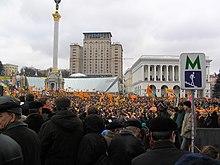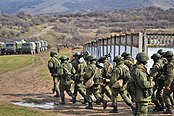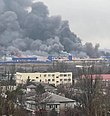
A | B | C | D | E | F | G | H | CH | I | J | K | L | M | N | O | P | Q | R | S | T | U | V | W | X | Y | Z | 0 | 1 | 2 | 3 | 4 | 5 | 6 | 7 | 8 | 9
| Russo-Ukrainian War | |||||||||
|---|---|---|---|---|---|---|---|---|---|
| Part of the conflicts in territory of the former Soviet Union | |||||||||
Clockwise from top left: Ukrainian tanks during the 2022 Kharkiv counteroffensive; Russian military vehicles with Z markings during the 2022 invasion; Russian-backed forces during the War in Donbas (2014–2022), 2015; Russian bombing during the Siege of Mariupol, 2022; Russian soldiers during the invasion of Crimea, 2014; Civilians killed by Russian missile strikes on Kyiv, 2022 | |||||||||
| |||||||||
| Belligerents | |||||||||
|
Supplied by: For countries providing aid to Ukraine since 2022, see military aid to Ukraine |
Supplied by: For details, see Russian military suppliers | ||||||||
| Commanders and leaders | |||||||||
|
| ||||||||
| Strength | |||||||||
|
For details of strengths and units involved at key points in the conflict, see: | |||||||||
| Casualties and losses | |||||||||
| Reports vary widely, but tens of thousands at a minimum.[3][4] See Casualties of the Russo-Ukrainian War for details. | |||||||||
The Russo-Ukrainian War[c] is an ongoing war between Russia and Ukraine, which began in February 2014. Following Ukraine's Revolution of Dignity, Russia occupied and annexed Crimea from Ukraine and supported pro-Russian separatists fighting the Ukrainian military in the Donbas war. The first eight years of conflict also included naval incidents, cyberwarfare, and heightened political tensions. In February 2022, Russia launched a full-scale invasion of Ukraine and began occupying more of the country.
In early 2014, the Euromaidan protests led to the Revolution of Dignity and the ousting of Ukraine's pro-Russian president Viktor Yanukovych. Shortly after, pro-Russian unrest erupted in eastern and southern Ukraine, while unmarked Russian troops occupied Crimea. Russia soon annexed Crimea after a highly disputed referendum. In April 2014, Russian-backed militants seized towns in Ukraine's eastern Donbas region and proclaimed the Donetsk People's Republic (DPR) and the Luhansk People's Republic (LPR) as independent states, starting the Donbas war. The separatists received considerable but covert support from Russia, and Ukrainian attempts to fully retake separatist-held areas failed. Although Russia denied involvement, Russian troops took part in the fighting. In February 2015, Russia and Ukraine signed the Minsk II agreements to end the conflict, but they were never fully implemented in the years that followed. The Donbas war settled into a violent but static conflict between Ukraine and the Russian and separatist forces, with many brief ceasefires but no lasting peace and few changes in territorial control.
Beginning in 2021, Russia built up a large military presence near its border with Ukraine, including within neighbouring Belarus. Russian officials repeatedly denied plans to attack Ukraine. Russian president Vladimir Putin expressed irredentist views and denied Ukraine's right to exist. He criticized the enlargement of NATO and demanded that Ukraine be barred from ever joining the military alliance. Russia recognized the DPR and LPR as independent states.
On 24 February 2022, Putin announced a "special military operation" to "demilitarize and denazify" Ukraine, claiming Russia had no plans to occupy the country. The Russian invasion that followed was internationally condemned; many countries imposed sanctions against Russia and increased existing sanctions. In the face of fierce resistance, Russia abandoned an attempt to take Kyiv in early April. From August, Ukrainian forces began recapturing territories in the north-east and south. In late September, Russia declared the annexation of four partially-occupied regions, which was internationally condemned. Russia spent the winter conducting inconclusive offensives in the Donbas. In spring 2023, Russia dug into positions ahead of another Ukrainian counteroffensive, which failed to gain significant ground. The war has resulted in a refugee crisis and tens of thousands of deaths.
Background
Independent Ukraine and the Orange Revolution

After the dissolution of the Soviet Union (USSR) in 1991, Ukraine and Russia maintained close ties. In 1994, Ukraine agreed to accede to the Treaty on the Non-Proliferation of Nuclear Weapons as a non-nuclear-weapon state.[5] Former Soviet nuclear weapons in Ukraine were removed and dismantled.[6] In return, Russia, the United Kingdom, and the United States agreed to uphold the territorial integrity and political independence of Ukraine through the Budapest Memorandum on Security Assurances.[7][8] In 1999, Russia was one of the signatories of the Charter for European Security, which "reaffirmed the inherent right of each and every participating State to be free to choose or change its security arrangements, including treaties of alliance, as they evolve."[9] In the years after the dissolution of the USSR, several former Eastern Bloc countries joined NATO, partly in response to regional security threats involving Russia such as the 1993 Russian constitutional crisis, the War in Abkhazia (1992–1993) and the First Chechen War (1994–1996). Putin said Western powers broke promises not to let any Eastern European countries join.[10][11]

The 2004 Ukrainian presidential election was controversial. During the election campaign, opposition candidate Viktor Yushchenko was poisoned by TCDD dioxin;[12][13] he later accused Russia of involvement.[14] In November, Prime Minister Viktor Yanukovych was declared the winner, despite allegations of vote-rigging by election observers.[15] During a two-month period which became known as the Orange Revolution, large peaceful protests successfully challenged the outcome. After the Supreme Court of Ukraine annulled the initial result due to widespread electoral fraud, a second round re-run was held, bringing to power Yushchenko as president and Yulia Tymoshenko as prime minister, and leaving Yanukovych in opposition.[16] The Orange Revolution is often grouped together with other early-21st century protest movements, particularly within the former USSR, known as colour revolutions. According to Anthony Cordesman, Russian military officers viewed such colour revolutions as attempts by the US and European states to destabilise neighbouring countries and undermine Russia's national security.[17] Russian President Vladimir Putin accused organisers of the 2011–2013 Russian protests of being former advisors to Yushchenko, and described the protests as an attempt to transfer the Orange Revolution to Russia.[18] Rallies in favour of Putin during this period were called "anti-Orange protests".[19]
At the 2008 Bucharest summit, Ukraine and Georgia sought to join NATO. The response among NATO members was divided. Western European countries opposed offering Membership Action Plans (MAP) to Ukraine and Georgia in order to avoid antagonising Russia, while US President George W. Bush pushed for their admission.[20] NATO ultimately refused to offer Ukraine and Georgia MAPs, but also issued a statement agreeing that "these countries will become members of NATO" at some point. Putin strongly opposed Georgia and Ukraine's NATO membership bids.[21] By January 2022, the possibility of Ukraine joining NATO remained remote.[22]
In 2009, Yanukovych announced his intent to again run for president in the 2010 Ukrainian presidential election,[23] which he subsequently won.[24] In November 2013, a wave of large, pro-European Union (EU) protests erupted in response to Yanukovych's sudden decision not to sign the EU–Ukraine Association Agreement, instead choosing closer ties to Russia and the Eurasian Economic Union. On 22 February 2013, the Ukrainian parliament overwhelmingly approved of finalizing Ukraine's agreement with the EU.[25] Subsequently, Russia pressurized Ukraine to reject this agreement by threatening sanctions. Kremlin adviser Sergei Glazyev stated that if the agreement was signed, Russia could not guarantee Ukraine's status as a state.[26][27]
Euromaidan, Revolution of Dignity, and pro-Russian unrest

On 21 February 2014, following months of protests as part of the Euromaidan movement, Yanukovych and the leaders of the parliamentary opposition signed a settlement agreement that provided for early elections. The following day, Yanukovych fled from the capital ahead of an impeachment vote that stripped him of his powers as president.[28][29][30][31] On 23 February, the Rada (Ukrainian Parliament) adopted a bill to repeal the 2012 law which made Russian an official language.[32] The bill was not enacted,[33] but the proposal provoked negative reactions in the Russian-speaking regions of Ukraine,[34] intensified by Russian media claiming that the ethnic Russian population was in imminent danger.[35]
Zdroj:https://en.wikipedia.org?pojem=Russian_military_intervention_in_Ukraine
Text je dostupný za podmienok Creative Commons Attribution/Share-Alike License 3.0 Unported; prípadne za ďalších podmienok. Podrobnejšie informácie nájdete na stránke Podmienky použitia.
Antropológia
Aplikované vedy
Bibliometria
Dejiny vedy
Encyklopédie
Filozofia vedy
Forenzné vedy
Humanitné vedy
Knižničná veda
Kryogenika
Kryptológia
Kulturológia
Literárna veda
Medzidisciplinárne oblasti
Metódy kvantitatívnej analýzy
Metavedy
Metodika
Text je dostupný za podmienok Creative
Commons Attribution/Share-Alike License 3.0 Unported; prípadne za ďalších
podmienok.
Podrobnejšie informácie nájdete na stránke Podmienky
použitia.
www.astronomia.sk | www.biologia.sk | www.botanika.sk | www.dejiny.sk | www.economy.sk | www.elektrotechnika.sk | www.estetika.sk | www.farmakologia.sk | www.filozofia.sk | Fyzika | www.futurologia.sk | www.genetika.sk | www.chemia.sk | www.lingvistika.sk | www.politologia.sk | www.psychologia.sk | www.sexuologia.sk | www.sociologia.sk | www.veda.sk I www.zoologia.sk






